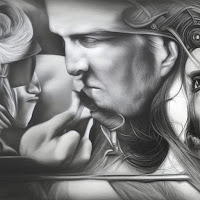Artificial intelligence (AI) has come a long way in recent years, and one area in which it has made significant strides is in the realm of image generation. AI image generators like DALL-E, Stable Difusion are able to create images from text prompts, and the results can be quite impressive. Although both machine learning and artists rely on images made before them, it's important to note that the creative process behind images constructed by image generators is quite different from that of an artist.
 |
| NighCafe Studio (25/01/2023) |
In contrast, AI image generators like DALL-E use a different approach. They are trained on a vast dataset of images, and they use this data to learn patterns and relationships between different elements. When presented with a text prompt, the AI uses these patterns to create an image that best matches the prompt. The AI does not have the ability to look at an image and find inspiration in the way an artist would. Instead, it finds common denominators based on the text prompt and creates an image accordingly.
 |
| NightCafe Studio (25/01/2023) |
It's worth noting that AI image generators can be a useful tool for artists, and can be used to create images that might not be possible with traditional techniques. For example, an artist might use AI to generate a complex pattern that they can then incorporate into their own work. Additionally, AI can be used to create variations on a theme, which can be a useful starting point for an artist to create their own unique work.
 |
| NightCafe Studio (25/01/2023) |
In conclusion, while AI image generators like DALL-E can create impressive images, the creative process behind them is quite different from that of an artist “even if both processes rely on previous traditions”. Artists look for inspiration in the work of other artists, the natural world and their own experiences, and emotions, whereas AI image generators rely on patterns learned from a vast dataset of images. The resulting images are highly detailed and formulaic, lacking the sense of spontaneity and individuality that is often present in the work of an artist. However, AI can be a useful tool for artists to generate variations on a theme and create images that might not be possible with traditional techniques.
PS Similar to the previous post, I kept the words I wrote and those of the OpenAI chatbot separate when I was writing this one. As it is visible, in this post, my words are almost insignificantly few. This is true, but not because the chatbot has evolved between posts so quickly that it no longer needs my input. This post differs from the previous one in that I provided a more detailed prompt this time, outlining the genre, the required length, the claim, as well as the supporting evidence and applications. This raises even another issue, namely how to conceptually and visually separate the various voices and determine what is my work and what is that of OpenAIchat. It is very likely that in the forthcoming posts I will explore this problem in more detail.


